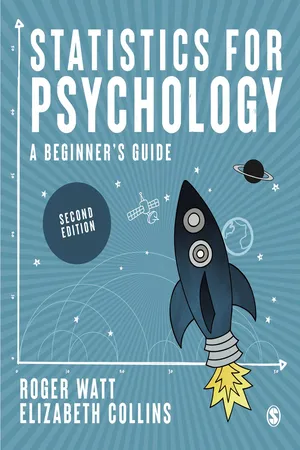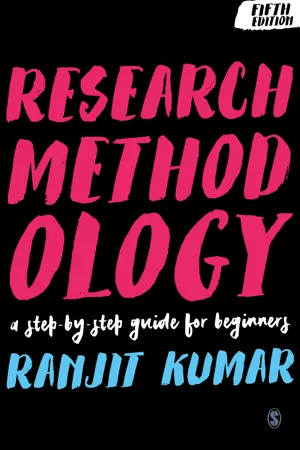Psychology
Types of Variable
In psychology, variables are categorized into different types based on their characteristics and measurement scales. The main types of variables include independent variables, which are manipulated by the researcher; dependent variables, which are the outcomes being measured; and control variables, which are held constant to prevent their influence on the relationship between the independent and dependent variables.
Written by Perlego with AI-assistance
Related key terms
Related key terms
1 of 4
Related key terms
1 of 3
6 Key excerpts on "Types of Variable"
- eBook - ePub
Statistics for Psychology
A Beginner′s Guide
- Roger Watt, Elizabeth Collins(Authors)
- 2023(Publication Date)
- SAGE Publications Ltd(Publisher)
Chapter 3 Variables You Might Want to Blend in but Being Different is More Interesting- 3.1 What are Variables? 32
- 3.2 Variability and Variables 36
- 3.3 Measuring Variables 39
- 3.4 Types of Measurement Value 41
- 3.5 Distributions of Values 45
- 3.6 Interval Variables 46
- 3.7 Ordinal Variables 50
- 3.8 Categorical Variables 52
- 3.9 Being a Responsible Researcher 53
A central notion in psychology is that interesting things like a person’s behaviour, thoughts and feelings have their roots in a complex combination of that person’s psychological make-up and their situation. Their psychological make-up comes from long-term traits such as their personality and short-term states such as their emotions, while their situation is made up of other people, experiences and meaningful objects that shape and constrain their behaviour. The first task in doing research is to break down all of this complexity into something that is simple enough to study and ultimately to understand. We do that by focusing on ways in which people and situations differ, and we describe the ways they differ as variables.Normally we encounter a person and all of their various qualities as one whole, but as a researcher we have to reduce that whole to a few distinct concepts or moments. These distinct entities become variables in research. For example, we might be interested in how happy a person becomes when they receive an unexpected compliment. Their happiness is a feeling or thought that they are experiencing and the compliment is an element of their situation. In this situation, we are taking the whole person and reducing them to these two parts – the compliment and their happiness – leaving everything else about them and their situation unexplored. - eBook - ePub
Research Methodology
A Step-by-Step Guide for Beginners
- Ranjit Kumar(Author)
- 2018(Publication Date)
- SAGE Publications Ltd(Publisher)
Table 5.2 shows some examples that will help you to understand the process of converting concepts into variables. Note that in these examples only some of the indicators have been picked up. Also, the values set for decision levels are arbitrary and have no empirical validity.One of the main differences between quantitative and qualitative research studies is in the area of variables. In qualitative research, as it usually involves studying perceptions, beliefs or feelings, you do not make any attempt to establish uniformity in them across respondents and hence measurements and variables do not carry much significance. On the other hand, in quantitative studies, as the emphasis is on exploring commonalities in the study population, measurements and variables play an important role.CheckpointDefining variablesTypes of Variable
A variable can be classified in a number of ways. The classification developed here results from looking at variables in three different ways (see Figure 5.1 ):- the causal relationship;
- the study design;
- the unit of measurement.
From the viewpoint of causal relationship
In studies that attempt to investigate a causal relationship or association, four sets of variables may operate (see Figure 5.2 ):- variables that are responsible for bringing about change in a phenomenon, situation or circumstance;
- outcome variables, which are the effects, impacts or consequences of a change variable;
- variables which affect or influence the link between cause-and-effect variables; and
- connecting or linking variables, which in certain situations are necessary to complete the relationship between cause-and-effect variables.
In research terminology, change variables are called independent variables, outcome/effect variables are called dependent variables, the unmeasured variables affecting the cause-and-effect relationship are called extraneous variables, and the variables that link a cause-and-effect relationship are called intervening variables - eBook - ePub
Applied Communication Research Methods
Getting Started as a Researcher
- Michael Boyle, Mike Schmierbach(Authors)
- 2023(Publication Date)
- Routledge(Publisher)
As was the case for independent variables, labeling something a dependent variable doesn’t necessarily mean it was caused by the independent variable. Additional elements must be considered to test for causality. Furthermore, a variable can serve as both an independent and dependent variable in different relationships. For example, whether people know that your shelter offers free clinic services might be a dependent variable when considering the relationship with exposure to social media messages. But it might be the independent variable when considering the relationship with the amount of money a person is willing to donate if knowing about the good an organization does makes people more willing to give. That said, certain variables can never or almost never be considered dependent variables. For example, age or race cannot be altered, and so anytime a variable like that is listed, you can be confident that it is serving as an independent variable or as a third variable.Third Variable
Not every variable tested in research is necessarily thought of as a dependent or independent variable. Many variables serve other roles, and thus they are generically referred to as third variables. Most common is the measurement of third variables that are meant to serve as control variables. When a variable is used as a control variable, the researcher wants to remove (or control) the influence that variable has in the relationship between the independent and dependent variables. Other types of third variables are used in evaluating mediation and moderation. In these cases, the third variable is expected to have an important influence, somehow contributing to or altering the relationship between the independent and dependent variables. Regardless of the specific role that a third variable plays, it must be carefully explicated and effectively measured, just like any other variable.The use of control variables is especially important in evaluating the relationship between independent and dependent variables. In many cases, there are numerous variables that share relationships with one another. However, researchers are often interested in testing only specific relationships between dependent and independent variables, as dictated by hypotheses or research questions. Control variables allow researchers to increase their confidence in findings showing a relationship between the variables of interest if a relationship is found after control variables are included. - eBook - ePub
- Pamela Balls Organista, Kevin Chun, Gerardo Marin, Pamela Balls Organista, Kevin Chun, Gerardo Marin(Authors)
- 2013(Publication Date)
- Routledge(Publisher)
The worst of these studies suffer from ethnocentric bias, but even the best have made little progress toward a theory that includes cultural variables that can account for both intracultural and cross-cultural variation; that is, that begins to answer questions of why incidence or prevalence rates differ across cultures or subcultures or why any two groups (either within or across cultures) score differently on a specific test. Given that both subdisciplines are concerned with qualitatively similar issues, it follows that the fundamental problems inherent in developing a theoretical paradigm to explain variations in psychopathology are the same whether or not cross-cultural variables are included. It is therefore more efficient to include culture-relevant variables from the beginning rather than to start with a strictly within-culture paradigm and to build from there. Furthermore, even a purely within-culture paradigm cannot be completely developed without a broader frame of reference. That is, culture-relevant variables are operating even within a culture (whether or not we choose to acknowledge them), but they can only be partially understood in that restricted context. Within-culture effects can only be fully clarified when the entire range of cultural variation is available for study. In familiar terms, focus on the restricted range of variation within a culture leads to a distorted view of overall relations among cultural variables.Even given the perspective that cross-cultural and mainstream psychology are complementary, indeed are mutually dependent fields, we are far from articulating a unified theory, and it is not the goal of this article to do so. Although several writers have set forth broad outlines for a substantive theory (e.g., Berry, 1980; Jahoda, 1980; Lonner, 1980; Segall, 1983; Triandis, Malpass, and Davidson, 1972), several more basic issues must be worked through before we can truly begin the task of building an integrated paradigm. I shall discuss two of these issues.Common Approach—A Psychological View of Cultural and Social Factors
A distinguishing feature of cross-cultural psychology is the prominence it gives to culture as a causal variable. In standard terminology, culture is the independent variable, so it would seem important to define it precisely and to specify the unit of analysis. Accordingly, a section defining culture is often found in general treatises on cross-cultural psychology (e.g., Brislin, 1983; Brislin et al., 1973; Jahoda, 1980; Price-Williams, 1975, 1980; Triandis, 1980b). Careful study of these works reveals that they can be placed along a continuum characterized by the degree to which culture is treated as a simple categorical variable versus a complex multidimensional structure. For simplicity’s sake, we can divide these studies into two types. It is not my intent to create divisions where they do not exist or to describe straw figures so that I may then knock them down. Rather, I hope to highlight some subtle differences in points of view within the field in order to focus more sharply on their implications (see Price-Williams, 1980, for a discussion of a related distinction). - eBook - ePub
Understanding Political Science Statistics
Observations and Expectations in Political Analysis
- Peter Galderisi(Author)
- 2015(Publication Date)
- Routledge(Publisher)
Statistics alone will not always allow us to determine the way in which a third variable intervenes, especially when the data, as in a survey, are all collected at the same time. That must be joined by our own theoretical and conceptual logic of a causal order between and among variables. However, the standard notion of introducing a third, control variable statistically uses the same logic. control variable A third variable that is used to eliminate the mediating effect that may cause us to misread the relationship between two variables specified in our hypothesis. Control variables allow us to parse out distinctions that our research designs do not directly allow. We cannot, for example, randomly assign individuals into districts or age categories. The notion of “statistical” control is not as valid as a properly designed experiment, but it allows us to approximate what a design, based on reality and often pre-collected data cannot afford us. We have already discussed potential problems with measurement: reliability, internal validity, and external validity. Internal validity and external validity can also apply to designs (i.e., how we test our hypotheses in the real world). Just as with measurements, it is basically impossible to create a test situation (design) totally free of internal and external validity problems. Before we elaborate, let’s once again make the distinction clear. IV stands for hypothesized independent variable; DV is the hypothesized outcome or dependent variable - Glenn Hymel(Author)
- 2005(Publication Date)
- Mosby(Publisher)
Chang et al. (2002) study, the researchers investigated two DVs: pain and anxiety intensity during labor.Extraneous Variable.
In studies comparable to the one we are considering, the researchers are principally—though not exclusively—interested in whether or not there is a meaningful relationship between the IV and the DV. However, many other variables are present in the study beyond the manipulated IV and the DV. These other variables may relate to characteristics of the study’s participants as well as to characteristics of the setting or circumstance in which the study is being conducted. They are present in the study, though not the principal or primary focus of the researchers’ interest, and, hence, are considered to be extraneous to the study’s major emphasis. Accordingly, any one of these variables is referred to as an extraneous variable simply because it is extraneous to the study’s main interest.Extraneous variables that pertain to characteristics of the study’s participants, sometimes also referred to as personological or organismic variables, include individual differences in traits and features that distinguish one person from another. These person-specific features include, to name only a few in a vast array of perhaps hundreds, such variables as health status, lifestyles and work habits, intelligence, socioeconomic status, race, gender, ethnicity, motivational and compliance tendencies, behavioral habits affecting one’s health, genetic inclinations, aptitudes, avocational interests, occupation, family of origin, self-esteem, and academic background.
Index pages curate the most relevant extracts from our library of academic textbooks. They’ve been created using an in-house natural language model (NLM), each adding context and meaning to key research topics.
Explore more topic indexes
Explore more topic indexes
1 of 6
Explore more topic indexes
1 of 4





